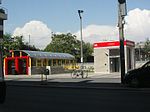Moleskine
Moleskine (Italian pronunciation: [moleˈskiːne]) is an Italian manufacturer, papermaker and product designer founded in 1997 by Francesco Franceschi, based in Milan, Italy. It produces and designs luxury notebooks, as well as planners, sketchbooks, leather backpacks, holdalls, journals, wallets, various accessories, and stationery. Moleskine's notebooks are stylised to follow the aesthetics of a 'traditional' black notebook with rounded corners and ivory-coloured paper. They are bound in cardboard with a sewn spine that allows the notebook to lie flat. An elastic band is used to seal, and a ribbon bookmark is included along with an expandable pocket inside the rear cover, which is packed in a paper banderole. Bruce Chatwin's name is used to sell Moleskine notebooks. Chatwin wrote in The Songlines of little black oilskin-covered notebooks that he bought in Paris and called "moleskines". The name Moleskine does not have an official pronunciation.
Excerpt from the Wikipedia article Moleskine (License: CC BY-SA 3.0, Authors).Moleskine
Viale Stelvio, Milan Municipio 9
Geographical coordinates (GPS) Address Nearby Places Show on map
Geographical coordinates (GPS)
| Latitude | Longitude |
|---|---|
| N 45.495444444444 ° | E 9.1825833333333 ° |
Address
Viale Stelvio 66
20159 Milan, Municipio 9
Lombardy, Italy
Open on Google Maps








